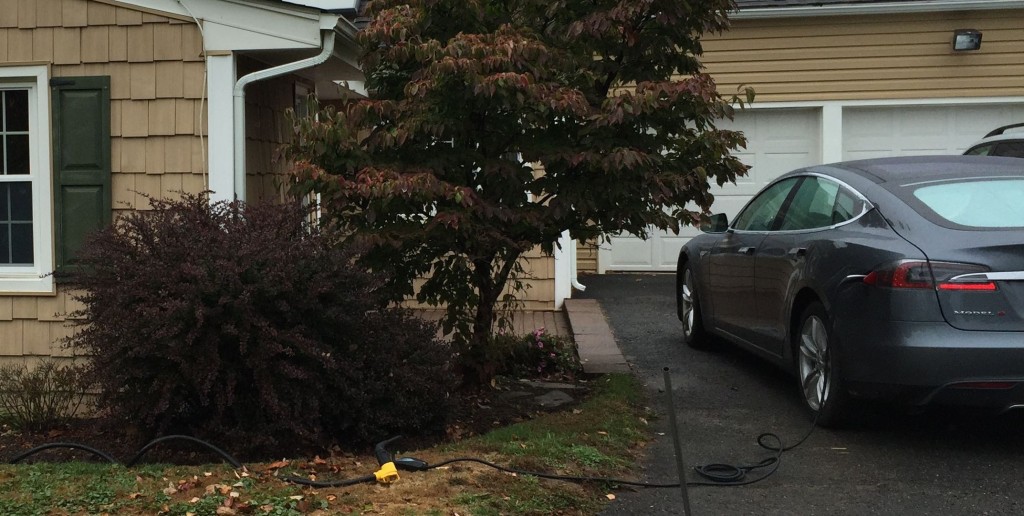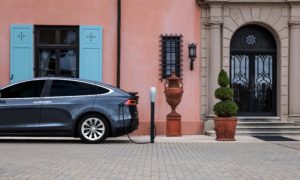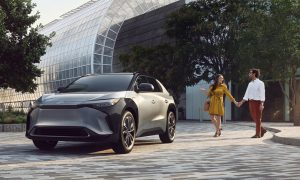DIY
Tesla Destination Charging Tips
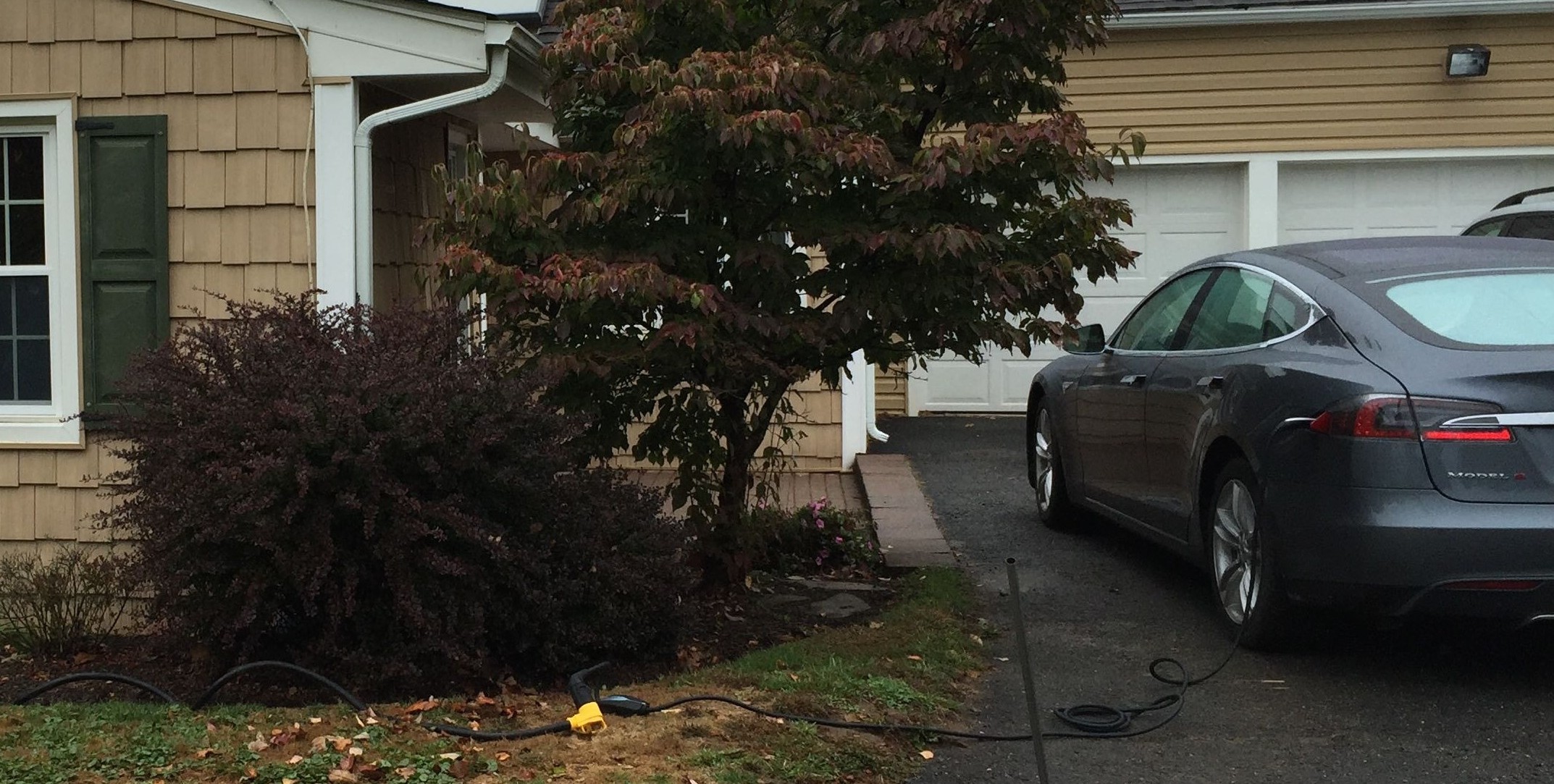
I learned a lot from my first Tesla road trip – mainly to enjoy the experience, decide how much charge you’ll need at each leg of the trip and plan out your destination charging.
What Type of Wall Outlet Do You Have?
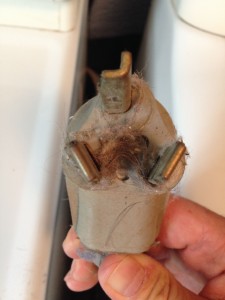 As EV owners we have a domain of expertise around charging amperage, EV specific lingo and an overall understanding of what’s needed when it comes to charging your car . However, relatives, friends and hotel staff may not necessarily be in the know of EV requirements. Case in point is the type of wall outlet that EVs can plug into. It’s your duty to plan ahead of time and figure out whether your destination charging will be anything more than a standard 100V wall outlet.
As EV owners we have a domain of expertise around charging amperage, EV specific lingo and an overall understanding of what’s needed when it comes to charging your car . However, relatives, friends and hotel staff may not necessarily be in the know of EV requirements. Case in point is the type of wall outlet that EVs can plug into. It’s your duty to plan ahead of time and figure out whether your destination charging will be anything more than a standard 100V wall outlet.
I happened to locate a beat up plug that led me to a NEMA 10-30 outlet at the destination of my last tesla road trip. The bad news was that I did not have an adapter available for the UMC and, even if I did, I couldn’t plug the car in since the only place I can park the Model S was nearly 40 feet away.
Official Tesla Motors Charge Adapters
Tesla Motors has UMC adapters for many of the common outlets, however at $45 + shipping I found it to be too expensive. Even with the adapter, the 20 foot UMC cable still wouldn’t get me to the outlet.
Tesla’s official statement is to avoid using extension cords when charging, but the reality is that many owners have resorted to using extension cords as a way to reach outlets much further away than what the UMC can support.
Aftermarket Charge Adapters
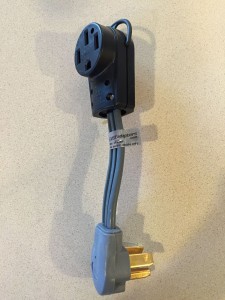 I came across EVSEadapters which specializes in adapters for people with EVs. They have a dedicated section for the Model S that contains many different types of plug adapters including the NEMA 14-50R to 10-30P adapter ($55) that I needed.
I came across EVSEadapters which specializes in adapters for people with EVs. They have a dedicated section for the Model S that contains many different types of plug adapters including the NEMA 14-50R to 10-30P adapter ($55) that I needed.
The adapters can be order with a short stub of a cable or with a 10 foot extension. Since 10 feet still wasn’t going to help me reach my outlet, I decided to purchase the shortest (and cheapest) version.
ALSO SEE: Tesla Expanding Charging Network Beyond Superchargers
The EVSEadapter folks put a very important reminder on the adapter that your max charge rate should be no more than 24A on this adapter. The reason for this is that outlets are rated at their max amperage but for continual draw (like a long charging session) you should only charge at 80% of that maximum. So a 10-30 outlet would not be designed or configured to sustain more than 80% x 30A = 24A of sustained draw.
Be sure to set your Model S charging amperage to a level that your outlet can support.
Why do you have to worry about it? The reason is that this adapter confuses the UMC into thinking it’s using a NEMA 14-50 outlet hence it will try to draw 80% of 50A or 40A which can be dangerous. So you need to be very careful and dial down the amperage to a level that your outlet can support.
The next step is getting this adapter to plug into the wall out that’s 40 feet away.
What Type of Extension Cords Are Safe?
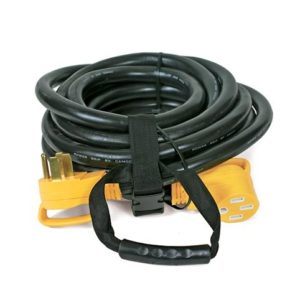
Camco 55195 50 AMP 30′ Extension Cord
If you want to extend high power over longer distances you need a thick enough cord that can support the additional current. I decided to extend the UMC’s NEMA 14-50 adapter by using a Camco 55195 50 AMP 30′ Extension Cord with PowerGrip Handle.
This super heavy duty (6 gauge) cord extends a NEMA 14-50 connection by 30′. It comes with a strap to hold the cables together as well as a carrying handle. You need all that because this sucker weighs in at 24 pounds! This one heavy duty cable costs about $100.
It’s vital to have a quality cable that can handle the current draw without heating up. A hot cable is not only an inefficient use of power (since the energy is converted into heat from the resistance) but also potentially dangerous.
Tesla Destination Charging Solution
With the adapter and extension cable, I was able to make it to the driveway with length to spare. I dialed down the Tesla Model S charge setting to 24 Amps, plugged her in and began watching it charge. I checked the outlet and each connection point to make sure no heat was building up.
The result? Cool as can be and I was charging at 18 miles/hour, 6x faster than a traditional 110V wall outlet!
The destination charging accessories cost me a total of $155, or essentially the cost of 2 tanks of gas which I would have paid anyway had I drove my old SUV. But more importantly, the increased charge rate gave me peace of mind to sightsee and travel locally without having to worry about going back to a 110V, 3 miles/hour destination charge.
Good destination charging makes for happy EV owners.
DIY
Tesla Model 3 pickup “Truckla” gets updates and a perfectly wholesome robot charger
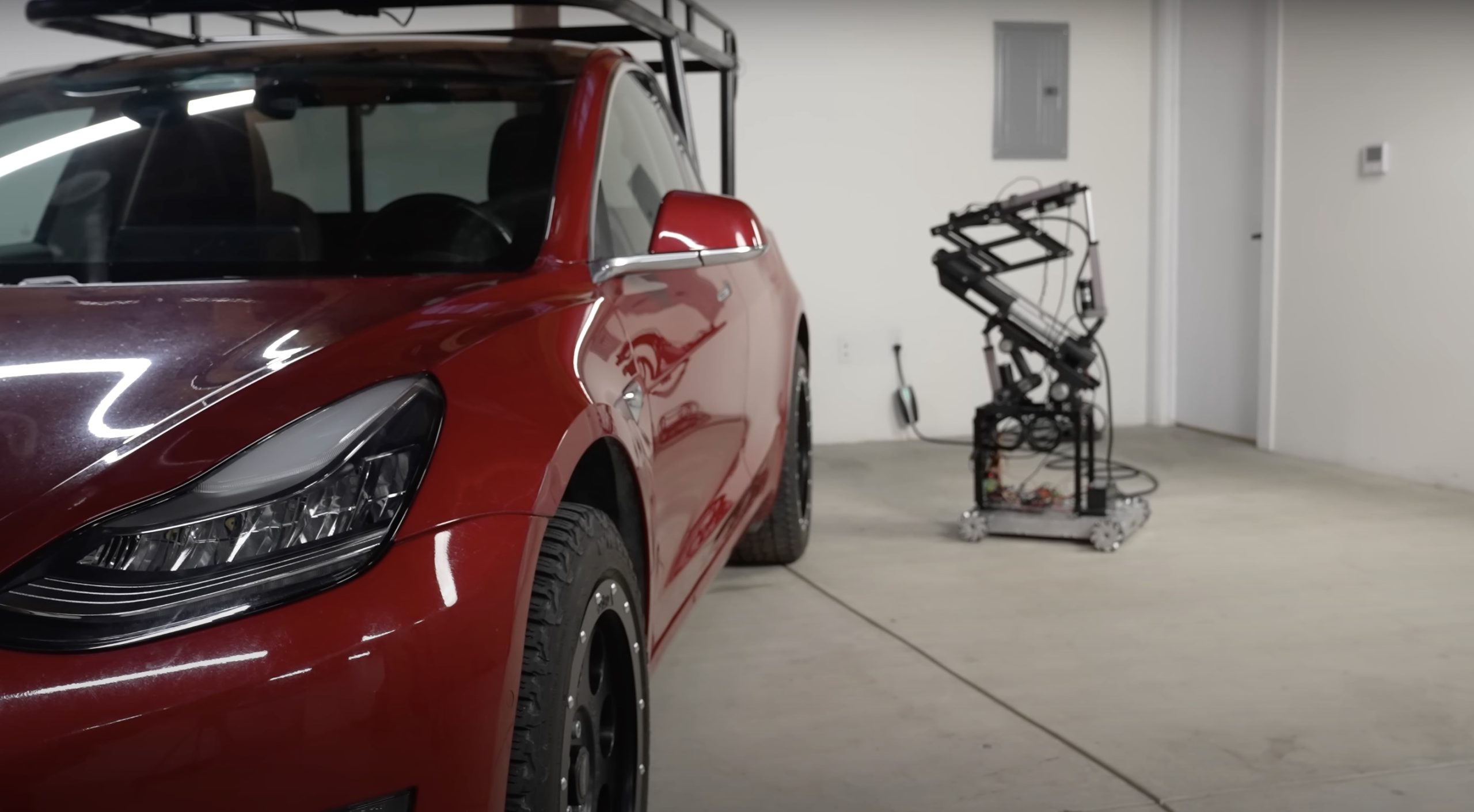
Back in 2019, YouTuber Simone Giertz, the self-proclaimed “Queen of Sh*tty Robots,” created a one-off Tesla Model 3 build that took the automotive world by storm. Fondly dubbed as “Truckla,” Giertz noted that the vehicle was actually her dream car — as crazy as that may sound.
Now almost four years later, the YouTuber posted an update on Truckla. And just like every other big project that one probably started, Giertz stated that she actually stopped working on Truckla when the vehicle was about 80% complete. The car is driving though, but a lot of stuff was not really working very well.
Thus, for her Truckla update, Giertz shared how most of her Model 3 pickup truck conversion was essentially completed. Truckla got a lot of detailing done, she got a slight lift, and she now has a functional tailgate. One has to admit, Truckla’s tailgate is pretty darn cool.
The “Queen of Sh*tty Robots” also opted to give Truckla a friend in the form of an automatic robot charger. Unlike Tesla’s rather interesting snake charger from years past, Truckla’s charger would come in the form of a rover, thanks to her friends at robotics platform Viam. Giertz aptly named Truckla’s robot charger friend “Chargela,” which is an appropriate name for such an invention.
Also true to form for Giertz, Chargela’s first encounter with Truckla was just a tiny bit awkward. One could say that Chargela may have just been a little bit nervous on his first try without human hands helping him. Most importantly, the system did work, so Giertz would likely keep using Chargela for her Model 3 pickup.
Teslas are very tech-heavy vehicles, so projects like Giertz’s Truckla are always remarkable. The fact that the Model 3 works perfectly fine despite having a good chunk of it cut off and turned into a pickup truck bed is mighty impressive any way one looks at it. Overall, Truckla will always be one of the coolest Tesla DIY projects to date, so any updates about the vehicle are always appreciated.
Truckla’s nearly four-year update can be viewed below.
Don’t hesitate to contact us with news tips. Just send a message to simon@teslarati.com to give us a heads up.
DIY
Tesla fan creating ‘CyberRoadster’ using Model 3 Performance parts in epic DIY build

A Tesla owner is taking his hobby and love for electric vehicles to new levels by creating what could only be described as one of the coolest EV-related DIY projects to date. The idea for the project is simple: what happens when you cross a supercar with the Cybertruck? You end up with a two-seater CyberRoadster.
Tesla owner David Andreyev, who goes by the username @Cyber_Hooligan_ on Twitter, has spent the last few months creating a Cybertruck-inspired version of the next-generation Roadster made from a salvaged Model 3 Performance. Starting with a Model 3 Performance is an inspired choice, considering that it is Tesla’s first vehicle that has a dedicated Track Mode.
A look at Andreyev’s YouTube channel, which can be accessed here, shows the meticulous build that the Tesla owner has implemented on the project car. What’s particularly cool about the CyberRoadster is the fact that it’s being built with parts that are also from other Tesla vehicles, like its front bumper that came from a new Model S. Recent videos suggest that the project car’s rear bumper will be from a new Model S as well.
The journey is long for Andreyev, so the completion of the CyberRoadster will likely take some more time. Despite this, seeing the Tesla owner’s DIY journey on such an epic build is more than satisfying. And considering that the CyberRoadster is evidently a labor of love from the Tesla owner, the final results would likely be extremely worth it.
There’s a lot of crazy Tesla modifications that have been done as of late. But some, as it is with a lot of things on the internet these days, have become more silly gimmicks than serious automotive projects. Fortunately, car enthusiasts like Andreyev, who just happen to also love electric vehicles, are taking it upon themselves to create one-of-a-kind EVs that would surely capture the attention of anyone on the road.
Check out the latest video in the CyberRoadster’s creation below.
Don’t hesitate to contact us with news tips. Just send a message to simon@teslarati.com to give us a heads up.
DIY
Tesla owner ‘charges’ Model 3 with homemade solar panel trailer
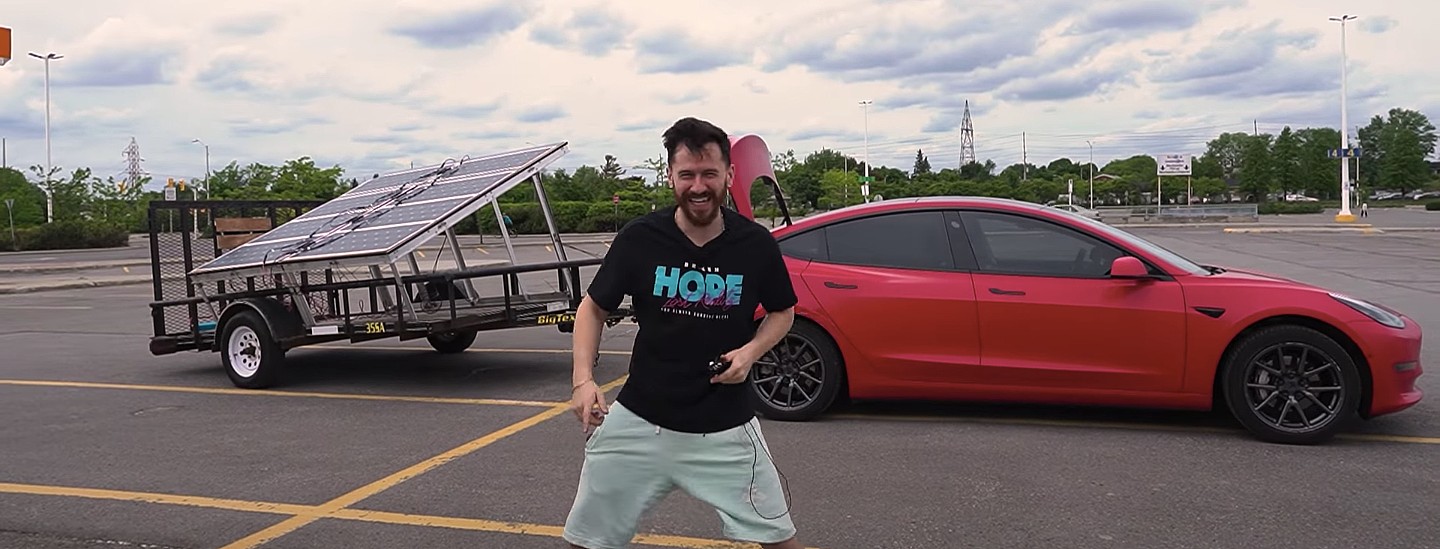
A Tesla owner has demonstrated a rather novel way to charge his Model 3. In a recent video, Sean Callaghan of the ItsYeBoi YouTube channel opted to use a series of off-the-shelf solar panel sheets onto a towable trailer to create a mobile charging unit for his all-electric sedan.
Callaghan planned to use only the sun and the solar sheets purchased from e-commerce platform Wish to charge his Model 3. The solar panel sheets would collect energy from the sun and transfer it to a control panel. The control panels were connected to batteries that would hold the energy—the batteries connected to an inverter, which would then charge the Tesla Model 3.
The entire assembly would provide the Model 3 with about 800 watts of energy on a completely sunny day. However, Callaghan shot the video when weather was overcast, so the entire solar panel trailer build only managed to provide around 300 watts throughout the YouTube host’s test.
To put this into perspective, a 100 volt home wall outlet provides 1.4 kilowatts of power, or 1,400 watts. Therefore, the 300-watt solar panel assembly built by Callaghan was producing less than 25% of the energy of a typical wall outlet. This is pretty marginal compared to Tesla’s 250-kilowatt V3 Superchargers, which provides 250,000 watts, or about 833 times as much power as the makeshift solar panel build.
However, Callaghan’s goal was not to charge the vehicle quickly. He explained the idea came from a previous video where he used a $5,000 Wish-purchased wind turbine to charge his Model 3. He wanted to test the effectiveness and efficiency of the system, which was questionable due to the time it would take to charge the battery fully.
The Model 3 battery pack is 78 kWh, and with Callaghan’s 300-watt system charging his electric vehicle, it would take 260 hours to supply the Tesla’s battery to full capacity.
In the past, electric vehicle enthusiasts have asked Tesla CEO Elon Musk why the company’s vehicles do not contain solar glass roofing, which would charge the car while the owner is driving. Musk has explained that the efficiency of this idea is challenging and likely would not provide an ample amount of range.
When asked about the idea of putting solar panels on the top of Tesla’s vehicles in 2017, Musk responded that the idea was “Not that helpful, because the actual surface of the car is not that much, and cars are often inside. The least efficient place to put solar is on the car.” It also would not be cost-effective for Tesla because “the cost of the panels and electronics, R&D and assembly would never pay for itself in the life of the vehicle, compared to charging from the wall in your garage,” Quartz noted.
That being said, Tesla plans to implement solar panels onto the motorized tonneau of the upcoming Cybertruck. The idea was discussed on Twitter when Musk stated that the optional feature would add “15 miles per day, possibly more” when parked in the sunlight. Also, fold-out solar wings could help capture enough solar energy for 30 to 40 miles a day.
Watch Sean Callaghan’s video of his makeshift solar panel trailer below.
-

 Elon Musk2 weeks ago
Elon Musk2 weeks agoTesla investors will be shocked by Jim Cramer’s latest assessment
-

 Elon Musk2 days ago
Elon Musk2 days agoxAI launches Grok 4 with new $300/month SuperGrok Heavy subscription
-

 Elon Musk4 days ago
Elon Musk4 days agoElon Musk confirms Grok 4 launch on July 9 with livestream event
-

 News1 week ago
News1 week agoTesla Model 3 ranks as the safest new car in Europe for 2025, per Euro NCAP tests
-

 Elon Musk2 weeks ago
Elon Musk2 weeks agoA Tesla just delivered itself to a customer autonomously, Elon Musk confirms
-

 Elon Musk1 week ago
Elon Musk1 week agoxAI’s Memphis data center receives air permit despite community criticism
-

 News2 weeks ago
News2 weeks agoXiaomi CEO congratulates Tesla on first FSD delivery: “We have to continue learning!”
-

 News2 weeks ago
News2 weeks agoTesla sees explosive sales growth in UK, Spain, and Netherlands in June

